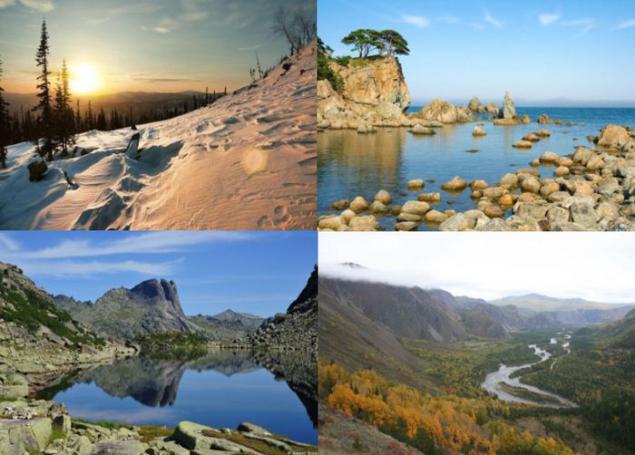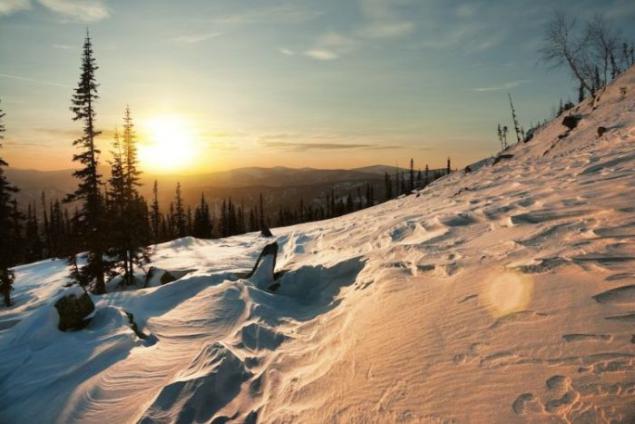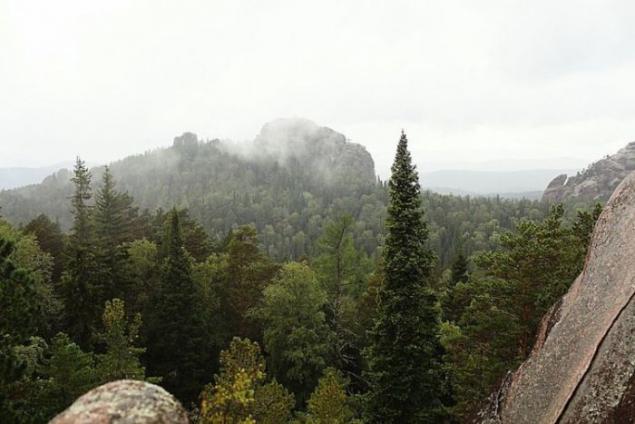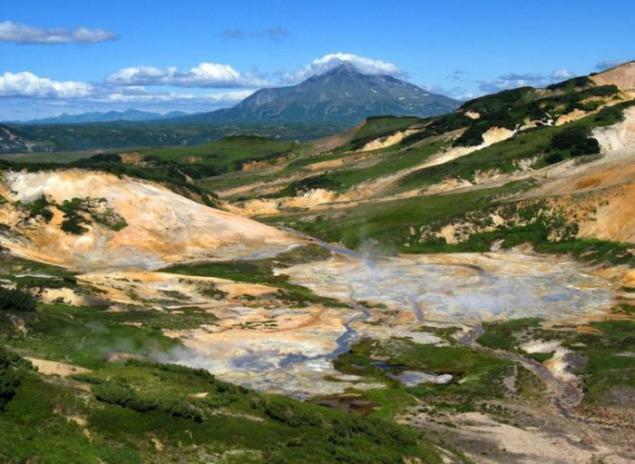1669
Amazing Russian reserves
In Russia, the stunning and unspoilt natural reserves. They are the most incredible places in our country.

Baikal Reserve

Around the deepest on the planet Lake Baikal - one of the largest sources of fresh water in the world - Baikal stretches fabulously beautiful park. The main part of the protected area is located on the southern shore of the lake in the central part of the Khamar-Daban. Around grow coniferous and deciduous forests, which are home to over 300 animal species and 80 plant species, about 25 of which are listed in the Red Book. In the rivers of the Baikal nature reserve are found black grayling, lenok, burbot and trout. They can even catch (not abuse, of course), and this deal with tourists and locals. If you have never tried fresh grayling, I assure, you should correct this omission. Those who have ever been in the Baikal Reserve, talk about its amazing effects on mental state. If you walk along the tourist routes (a reserve is open to visitors, you can safely walk with a backpack for weeks), then to penetrate the soul of spirituality and peace, and you go back to the usual bustle of the city have a completely different person. If you are seeking an active holiday, then you can just stay in one of the tourist camping on the lake: the prices are very democratic, and local residents and owners of "tourist villages" - welcoming and friendly. In Lake Baikal inhabit one of three species of freshwater seals - seals that says a lot about the quality of water in the lake: the seal in dirty water can not live. In the reserve there are predators: wolverines, bears. And recently, the network has a webcam, which goes live broadcast from the nest White-tailed Eagle.
Kuznetsky Alatau

Reserve Kuznetsky Alatau is located in the south central Siberia. This is an amazing place with unique ecosystem. The valley surrounded by high mountains stretches virgin pine forest, where there are thickset cedars, flowing crystal-clear mountain streams of ice water, and the glaciers and underground water table is fed huge deep lakes. The reserve is extremely popular with local tourists both in winter and in summer you can find whole groups of people with heavy rucksacks on their backs. Routes in the tourist area is not complicated, there are convenient trodden trails and shelters - houses where you can stay if you do not like to spend the night in a tent. Typically, the distance between the transition takes one day or less. However, everything is easy only as long as you do not go through the pass Karatashsky not get into the most interesting place of the reserve - the Golden Valley. Part of the valley is well understood, but there is much more wild places where no one goes, except for deer and bears. However, getting lost is impossible: with a map of the rivers can go to human habitation, the aforementioned shelters. Being in the valley, it is necessary to look at the beautiful lake Haratas. It is fed by the huge coming down from the high mountains waterfalls, and is found in the waters of the real trout.
Altai Reserve

Altai reserve on the list of World Cultural and Natural Heritage under the name "Golden Mountains of Altai", and it is one of the major Russian reserves. He almost all sides is surrounded by high mountains, and to the south it is adjacent to the huge Lake Teletskoye. It is noteworthy that throughout the natural area there is no road. Nevertheless, this fact makes it even more attractive for tourists. The main part of the reserve occupies a wild forest where you can meet only rare foresters paved trails. More there are 1190 lakes - all with clean cold water. Nearby is the highest peak in the Altai Mountains and Siberia - Belukha, which has no special equipment and training is a good climb. In general, the average height of the mountains - about 2000 m above sea level, which is not so high: the pass can rise anyone. In the mountains, wandering the most interesting: you can see the extraordinary beauty of landscape, and if you're lucky, an extremely rare and precious animals, listed in the Red Book of Russia - the snow leopard. You can honestly say: the beauty of the Altai mountains in no way inferior to the Alps, only Altai - the territory is much more wild. Luxury hotel, you will not find here, but the adventure of extreme climbs, descents - no problem. Fans of quiet rest can advise the village on the shore of Lake Teletskoye: it offers a cozy wooden house at the price of 300 rubles per person per day, a delicious skewers of fresh meat and real Russian banya.
Poles

State Nature Reserve "Pillars" - a truly unique phenomenon. It includes part of the Eastern Sayan Mountains. The main attraction of the area is amazing syenite outcrops - so-called "pillars". Some of the rocks are open for tourists, and some are located in the depths of the reserve, and access to them is limited in order to preserve intact a unique natural phenomenon and a special, peculiar to these places ecosystems. These rocks were the cause of so-called "stolbizma." People often come here and climb over rocks in an informal setting, sometimes even without insurance. In general, then, in terms of mountaineering, poles - not the most complex objects, so as insurance in most cases usual rope. The goal - to climb to the top of a column. Like most Russian reserves, a large part of "Pillars" is covered by forests, here - fir. By the way, part of the reserve is almost directly adjacent to Krasnoyarsk, and there is a great ski resort.
Kronotsky

Kronotsky Nature Reserve - one of the oldest protected areas in Russia. It is located on the Kamchatka Peninsula and adjacent to the Pacific Ocean. It was here that the famous active volcano kronotsky, many waterfalls, the Valley of Geysers and the thermal lake. About the Valley of Geysers is a special subject. Let's start with the fact that it is included in the official list of the Seven Wonders of Russia. This is the only place on the continent of Eurasia, where there is a geyser field, and the size of this area many times larger than the famous geyser field in Iceland. This ecosystem is extremely fragile and vulnerable to external influences. Bonfires on the reserve are strictly prohibited. Despite the difficult conditions, the Valley of Geysers - a popular destination among tourists. In the 2007- year access to it tried to limit almost at the legislative level, but Vladimir Putin said: "This decision should be based solely on expert opinion." So the entrance to the valley is still free. In general, opening the mountain views of the steaming plains - a fascinating spectacle which saw once, you will never forget. In addition, it contains Russia's largest population of brown bears: according to recent data, this species there are about 700. But because the peninsula is not conducted any mining, and, therefore, a person almost does not interfere with the natural development of the life of this natural edge , the extinction of the bears is not threatened.
Caucasian Reserve

Caucasus Nature Reserve is mainly mountainous territory. It is located on the northern and southern slopes of the Western Caucasus, and also included in the list of World Natural Heritage. Caucasian Reserve - untouched by human land that makes it comfortable to live and breed rare and bison tours. By the way, it is not far from the famous city of Sochi, and rivers that originates in the mountains of the Caucasus Nature Reserve, water supply Sochi resort, and numerous forests provide fresh air. The territory of the reserve consists of the Caucasus Mountains. It is here that the mountain-five thousand meters Elbrus and Kazbek, the slopes of which have never been the snow melts. By the way, Elbrus - the highest point of Europe and go to conquer its mountaineers from around the world. By the way, even for an experienced climber Elbrus - not the easiest route. We should also mention the fabulously beautiful lake Kezenoyam. Its waters in sunny weather have a bright blue color, and it is - the deepest and largest lake in the North Caucasus. The lake is home to fish species, nowhere else in the world do not occur - Salmo Ezenami. Currently under construction on the lake hotel.
Great Arctic Reserve

There are vast arctic deserts and arctic tundra. Most of the year in the area immediately adjacent to the Arctic Circle, snow, coming down only in the summer for a short time. Great Arctic - the largest on the territory of Eurasia reserve and home to polar bears. Unlike other parks, there are also industrial areas, for example, in some places produce oil. The coastline of the reserve bordering the Arctic Ocean.
Sayano-Shushenskaya Reserve

In the Sayano-Shushenskoye Reserve are the largest in size (about 1,000 km²) pine forest. The main terrain - mountains and mountain valleys, with some peaks reaching a height of almost 3000 meters above sea level. This reserve is home to about 100 species of rare or endangered animals. For example, here lives the largest population of snow leopards in the world. However, according to some leopards critical situation: according to the deputy director for scientific work of the Sayano-Shushenskoye Biosphere Reserve Sergei Istomova, there remains no more than a dozen wild snow leopards, not dozens, as stated in the official documents. Unfortunately, in 1975 in these places it was opened reservoir. Yenisei River was blocked, and as a result there was extensive flooding of land. Then everything disappeared that lived on the narrow coastal strip. Fortunately, after about five years the situation has returned to normal, but some species have not been able to adapt to new conditions and left the place. Of course, where the mountains - there and tourists. However, here it is developed mainly hiking and mountain climbing, and hotel complexes virtually none.
Vasyugan swamp

In Western Siberia, between the rivers Irtysh and Ob, spread some of the largest wetlands in the world. The region is one of the main sources of fresh water. Tourists visit these places rarely few risks to roam the vast expanses of water flooding, but in most places the swamps are not deep. Of course, in these wild places home to rare species of birds and animals. However, walking through the swamps for many days visitors can: the boundless fields of water there is quite dry forested islands. That's just for the ignition of the fire you light a huge fine: like human intervention causing the ecosystem of these places considerable damage. Unfortunately, the safety of the reserve is under threat, as the marsh - it's not only fresh water and a rich fauna, and more and peat, oil and natural gas. So far, no industrial development in this area is not conducted, but the development of mineral resources may begin in the next few years. No less harmful from this standpoint the nearby spaceport "Baikonur", as the substance of launch vehicles fall into the water.
Far Eastern Marine Reserve

The aim of this reserve was to preserve rare species of marine and coastal animals and plants. In some areas a person is forbidden to go, but the fact remains that the share of tourists is enough. However, here it is completely banned fishing and hunting, so I have to be content with only admiration of the beauty of nature. And it has something to admire. The visitor will clear sea with untouched narrow grassy beaches, low deciduous forest. The warm sea waters inhabited even tropical sharks and sea snakes. In general, the animal world, both under water and on the surface, is extremely diverse, but most animals, unfortunately, is also under threat of extinction. In the northern area of the reserve there is a hotel, where you can comfort, though no frills, relaxing on the beach.
Source: khabarovsk.shamora.info

Baikal Reserve

Around the deepest on the planet Lake Baikal - one of the largest sources of fresh water in the world - Baikal stretches fabulously beautiful park. The main part of the protected area is located on the southern shore of the lake in the central part of the Khamar-Daban. Around grow coniferous and deciduous forests, which are home to over 300 animal species and 80 plant species, about 25 of which are listed in the Red Book. In the rivers of the Baikal nature reserve are found black grayling, lenok, burbot and trout. They can even catch (not abuse, of course), and this deal with tourists and locals. If you have never tried fresh grayling, I assure, you should correct this omission. Those who have ever been in the Baikal Reserve, talk about its amazing effects on mental state. If you walk along the tourist routes (a reserve is open to visitors, you can safely walk with a backpack for weeks), then to penetrate the soul of spirituality and peace, and you go back to the usual bustle of the city have a completely different person. If you are seeking an active holiday, then you can just stay in one of the tourist camping on the lake: the prices are very democratic, and local residents and owners of "tourist villages" - welcoming and friendly. In Lake Baikal inhabit one of three species of freshwater seals - seals that says a lot about the quality of water in the lake: the seal in dirty water can not live. In the reserve there are predators: wolverines, bears. And recently, the network has a webcam, which goes live broadcast from the nest White-tailed Eagle.
Kuznetsky Alatau

Reserve Kuznetsky Alatau is located in the south central Siberia. This is an amazing place with unique ecosystem. The valley surrounded by high mountains stretches virgin pine forest, where there are thickset cedars, flowing crystal-clear mountain streams of ice water, and the glaciers and underground water table is fed huge deep lakes. The reserve is extremely popular with local tourists both in winter and in summer you can find whole groups of people with heavy rucksacks on their backs. Routes in the tourist area is not complicated, there are convenient trodden trails and shelters - houses where you can stay if you do not like to spend the night in a tent. Typically, the distance between the transition takes one day or less. However, everything is easy only as long as you do not go through the pass Karatashsky not get into the most interesting place of the reserve - the Golden Valley. Part of the valley is well understood, but there is much more wild places where no one goes, except for deer and bears. However, getting lost is impossible: with a map of the rivers can go to human habitation, the aforementioned shelters. Being in the valley, it is necessary to look at the beautiful lake Haratas. It is fed by the huge coming down from the high mountains waterfalls, and is found in the waters of the real trout.
Altai Reserve

Altai reserve on the list of World Cultural and Natural Heritage under the name "Golden Mountains of Altai", and it is one of the major Russian reserves. He almost all sides is surrounded by high mountains, and to the south it is adjacent to the huge Lake Teletskoye. It is noteworthy that throughout the natural area there is no road. Nevertheless, this fact makes it even more attractive for tourists. The main part of the reserve occupies a wild forest where you can meet only rare foresters paved trails. More there are 1190 lakes - all with clean cold water. Nearby is the highest peak in the Altai Mountains and Siberia - Belukha, which has no special equipment and training is a good climb. In general, the average height of the mountains - about 2000 m above sea level, which is not so high: the pass can rise anyone. In the mountains, wandering the most interesting: you can see the extraordinary beauty of landscape, and if you're lucky, an extremely rare and precious animals, listed in the Red Book of Russia - the snow leopard. You can honestly say: the beauty of the Altai mountains in no way inferior to the Alps, only Altai - the territory is much more wild. Luxury hotel, you will not find here, but the adventure of extreme climbs, descents - no problem. Fans of quiet rest can advise the village on the shore of Lake Teletskoye: it offers a cozy wooden house at the price of 300 rubles per person per day, a delicious skewers of fresh meat and real Russian banya.
Poles

State Nature Reserve "Pillars" - a truly unique phenomenon. It includes part of the Eastern Sayan Mountains. The main attraction of the area is amazing syenite outcrops - so-called "pillars". Some of the rocks are open for tourists, and some are located in the depths of the reserve, and access to them is limited in order to preserve intact a unique natural phenomenon and a special, peculiar to these places ecosystems. These rocks were the cause of so-called "stolbizma." People often come here and climb over rocks in an informal setting, sometimes even without insurance. In general, then, in terms of mountaineering, poles - not the most complex objects, so as insurance in most cases usual rope. The goal - to climb to the top of a column. Like most Russian reserves, a large part of "Pillars" is covered by forests, here - fir. By the way, part of the reserve is almost directly adjacent to Krasnoyarsk, and there is a great ski resort.
Kronotsky

Kronotsky Nature Reserve - one of the oldest protected areas in Russia. It is located on the Kamchatka Peninsula and adjacent to the Pacific Ocean. It was here that the famous active volcano kronotsky, many waterfalls, the Valley of Geysers and the thermal lake. About the Valley of Geysers is a special subject. Let's start with the fact that it is included in the official list of the Seven Wonders of Russia. This is the only place on the continent of Eurasia, where there is a geyser field, and the size of this area many times larger than the famous geyser field in Iceland. This ecosystem is extremely fragile and vulnerable to external influences. Bonfires on the reserve are strictly prohibited. Despite the difficult conditions, the Valley of Geysers - a popular destination among tourists. In the 2007- year access to it tried to limit almost at the legislative level, but Vladimir Putin said: "This decision should be based solely on expert opinion." So the entrance to the valley is still free. In general, opening the mountain views of the steaming plains - a fascinating spectacle which saw once, you will never forget. In addition, it contains Russia's largest population of brown bears: according to recent data, this species there are about 700. But because the peninsula is not conducted any mining, and, therefore, a person almost does not interfere with the natural development of the life of this natural edge , the extinction of the bears is not threatened.
Caucasian Reserve

Caucasus Nature Reserve is mainly mountainous territory. It is located on the northern and southern slopes of the Western Caucasus, and also included in the list of World Natural Heritage. Caucasian Reserve - untouched by human land that makes it comfortable to live and breed rare and bison tours. By the way, it is not far from the famous city of Sochi, and rivers that originates in the mountains of the Caucasus Nature Reserve, water supply Sochi resort, and numerous forests provide fresh air. The territory of the reserve consists of the Caucasus Mountains. It is here that the mountain-five thousand meters Elbrus and Kazbek, the slopes of which have never been the snow melts. By the way, Elbrus - the highest point of Europe and go to conquer its mountaineers from around the world. By the way, even for an experienced climber Elbrus - not the easiest route. We should also mention the fabulously beautiful lake Kezenoyam. Its waters in sunny weather have a bright blue color, and it is - the deepest and largest lake in the North Caucasus. The lake is home to fish species, nowhere else in the world do not occur - Salmo Ezenami. Currently under construction on the lake hotel.
Great Arctic Reserve

There are vast arctic deserts and arctic tundra. Most of the year in the area immediately adjacent to the Arctic Circle, snow, coming down only in the summer for a short time. Great Arctic - the largest on the territory of Eurasia reserve and home to polar bears. Unlike other parks, there are also industrial areas, for example, in some places produce oil. The coastline of the reserve bordering the Arctic Ocean.
Sayano-Shushenskaya Reserve

In the Sayano-Shushenskoye Reserve are the largest in size (about 1,000 km²) pine forest. The main terrain - mountains and mountain valleys, with some peaks reaching a height of almost 3000 meters above sea level. This reserve is home to about 100 species of rare or endangered animals. For example, here lives the largest population of snow leopards in the world. However, according to some leopards critical situation: according to the deputy director for scientific work of the Sayano-Shushenskoye Biosphere Reserve Sergei Istomova, there remains no more than a dozen wild snow leopards, not dozens, as stated in the official documents. Unfortunately, in 1975 in these places it was opened reservoir. Yenisei River was blocked, and as a result there was extensive flooding of land. Then everything disappeared that lived on the narrow coastal strip. Fortunately, after about five years the situation has returned to normal, but some species have not been able to adapt to new conditions and left the place. Of course, where the mountains - there and tourists. However, here it is developed mainly hiking and mountain climbing, and hotel complexes virtually none.
Vasyugan swamp

In Western Siberia, between the rivers Irtysh and Ob, spread some of the largest wetlands in the world. The region is one of the main sources of fresh water. Tourists visit these places rarely few risks to roam the vast expanses of water flooding, but in most places the swamps are not deep. Of course, in these wild places home to rare species of birds and animals. However, walking through the swamps for many days visitors can: the boundless fields of water there is quite dry forested islands. That's just for the ignition of the fire you light a huge fine: like human intervention causing the ecosystem of these places considerable damage. Unfortunately, the safety of the reserve is under threat, as the marsh - it's not only fresh water and a rich fauna, and more and peat, oil and natural gas. So far, no industrial development in this area is not conducted, but the development of mineral resources may begin in the next few years. No less harmful from this standpoint the nearby spaceport "Baikonur", as the substance of launch vehicles fall into the water.
Far Eastern Marine Reserve

The aim of this reserve was to preserve rare species of marine and coastal animals and plants. In some areas a person is forbidden to go, but the fact remains that the share of tourists is enough. However, here it is completely banned fishing and hunting, so I have to be content with only admiration of the beauty of nature. And it has something to admire. The visitor will clear sea with untouched narrow grassy beaches, low deciduous forest. The warm sea waters inhabited even tropical sharks and sea snakes. In general, the animal world, both under water and on the surface, is extremely diverse, but most animals, unfortunately, is also under threat of extinction. In the northern area of the reserve there is a hotel, where you can comfort, though no frills, relaxing on the beach.
Source: khabarovsk.shamora.info























